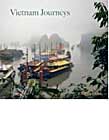Vietnam Journeys, text by Mary Ann Bragg (Botswana 1980–82)
 Vietnam Journeys
Vietnam Journeys
Photography by Charles Fields
Introduction and text by Mary Ann Bragg (Botswana 1980–82)
Fields Publishing
264 pages
$50.00
Reviewed by Richard Lipez (Ethiopia 1962-64)
WHEN THE PICTURE-TAKING COMMENCES at a family gathering of ours, just before the shutter clicks my mother-in-law jokingly commands everybody to “look pleasant!” In Fields’s big, handsome, underly satisfying book of photos of Vietnam and Vietnamese life, he seems to have urged Vietnam to “look pleasant,” and it obliged.
It’s true that Vietnam is in decent shape overall. The free-market reforms of the ’80s have the economy moving at a steady trot (though foreign investors complain that the bureaucracy is still godawful), and most of the population isn’t old enough to remember “the American war”; the chief preoccupation of the young seems to be charging into the neon-lit, mall-culture, consumerist future. Based on what I saw of the Socialist Republic of Vietnam during a visit four years ago, I’d guess that Jack Welch’s books outsell Karl Marx’s. Or they would if they were available; I’ll bet they aren’t in a society where the thought police probably outnumber the traffic cops (of whom there appear to be none).
Fields’s Vietnam is true as far as it goes. He offers page after page of lovely green landscapes peopled by contented folk at work and play. There are the early risers — farmers and fishermen — and the urban hipsters who stay up late and love song voi, living fast. We see the rural hill tribes — the Hmong, the Dao and the Tay — in their bright get-ups. There are war vets from Dien Bien Phu, artisans and food vendors, people building houses.
I don’t doubt that these pictures show a real, if partial, Vietnam. Fields plainly loves Vietnam, and I’ll bet his subjects saw that affection and responded by peering into his camera and, well — looking pleasant. I’m sure that most Vietnamese are happy and relaxed at times. But, hey, come on! Virtually nobody who appears in this book seems to have a care in the world. The “impoverished families” aided by a women’s club in Hanoi look like people in toothpaste ads. Even when the text gives us some bad news, it comes with a big grin. The “human trafficking” horrors described — just mentioned in passing, really — on page 140 are accompanied by a picture of a happy farm girl with a hoe over her shoulder. I looked closely at the water buffalo on the next page to see if it was smiling, too; I was surprised to see that it wasn’t.
Where are the political dissidents? Locked up, that’s where. There’s no mention of them. Nor do we get a glimpse of the deformed Agent Orange victims dragging themselves around the streets of Saigon hawking lottery tickets. True, I don’t know how you’d photograph this, but one of my most indelible memories of Hanoi was being awakened at four in the morning by loudspeakers outside my hotel room window blasting patriotic songs and urgently alerting the population to the dangers of “imperialism.” The government of Vietnam on those rare occasions when it appears in the text or photos in this book is an implausibly benign presence.
Likewise representations of “Uncle Ho.” Here’s the complete text accompanying a picture of the entrance to Ho Chi Minh’s very weird resting place: “A statuesque mausoleum in Ba Dinh Square in Hanoi holds the body of the man considered the greatest leader of Vietnam, Chu Tich (President) Ho Chi Minh, who died in 1969. His body, dressed in his characteristic faded khaki clothes and plain rubber shoes, was placed in a glass coffin. Construction began in 1973 and was completed two years later.” There’s no mention that the place looks like a Cruise missile factory in Pittsfield, that the Pop-Tart-like corpse of the poor old guy is lit like Judy Garland at Carnegie Hall, and that while the Vietnamese young still revere Ho as a nationalist hero, he is also widely regarded as an economic crackpot.
A clue to the overall tone of Vietnam Journeys can be found in this publisher’s note: “Fields offers . . . photographic tours and seminars in Vietnam for photographers and aspiring photographers.” The book is the work, I am guessing, of a humane and capable photographer who above all wants to have his visa renewed.
Richard Lipez writes the Don Strachey private eye novels under the name Richard Stevenson. He lives in Thailand in the winter and has written about Southeast Asia for a number of publications.
No comments yet.
Add your comment